Dalla rivista Volare - FalcoClub
Menu principale:
- Separatore 8
- Home Page
- Separatore 1
- News
- Separatore 2
- I nostri gioielli
- Separatore 3
- Falchi & Co. 1
- Separatore 4
- Falchi & Co. 2
- Separatore 5
- I nostri Campioni
- Separatore 6
- Italia, popolo di poeti ...
- Separatore 11
- Parlano di noi e ...........
- Separatore 7
- Galleria
- Separatore 10
- Bacheca
- Separatore 9
- Contatti e Links
Dalla rivista Volare
Volare di Luglio 1985
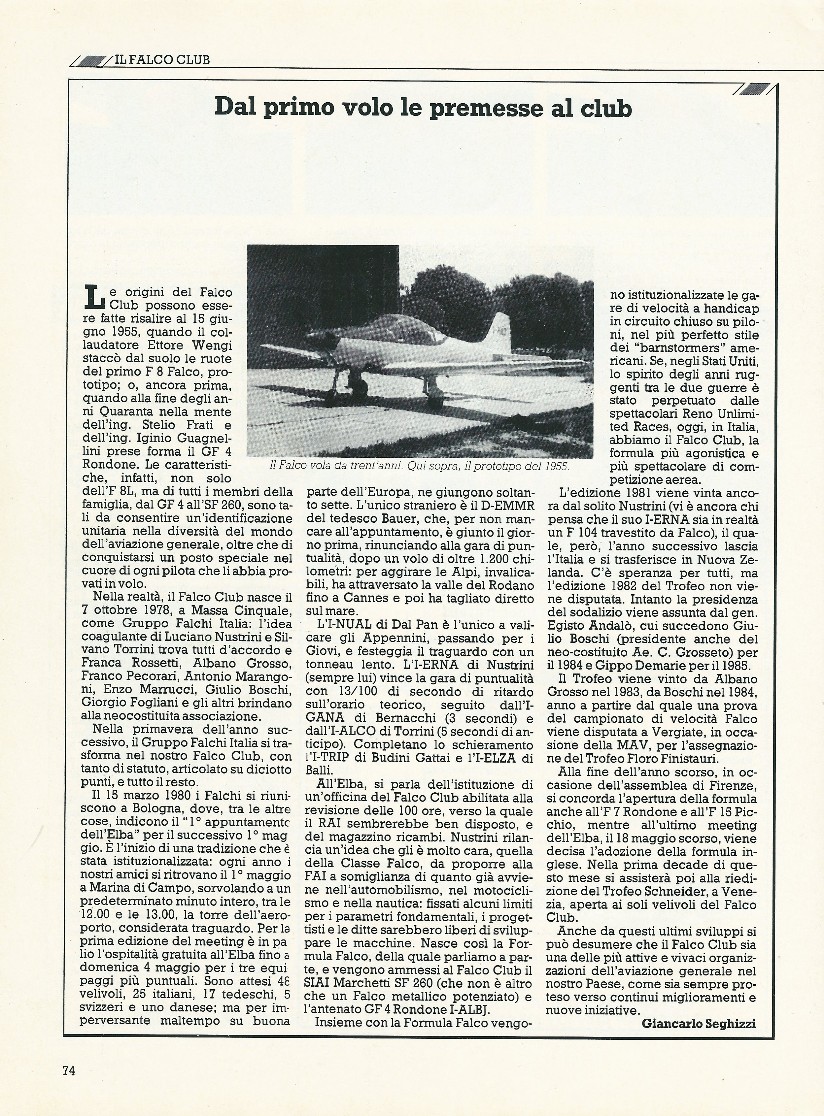
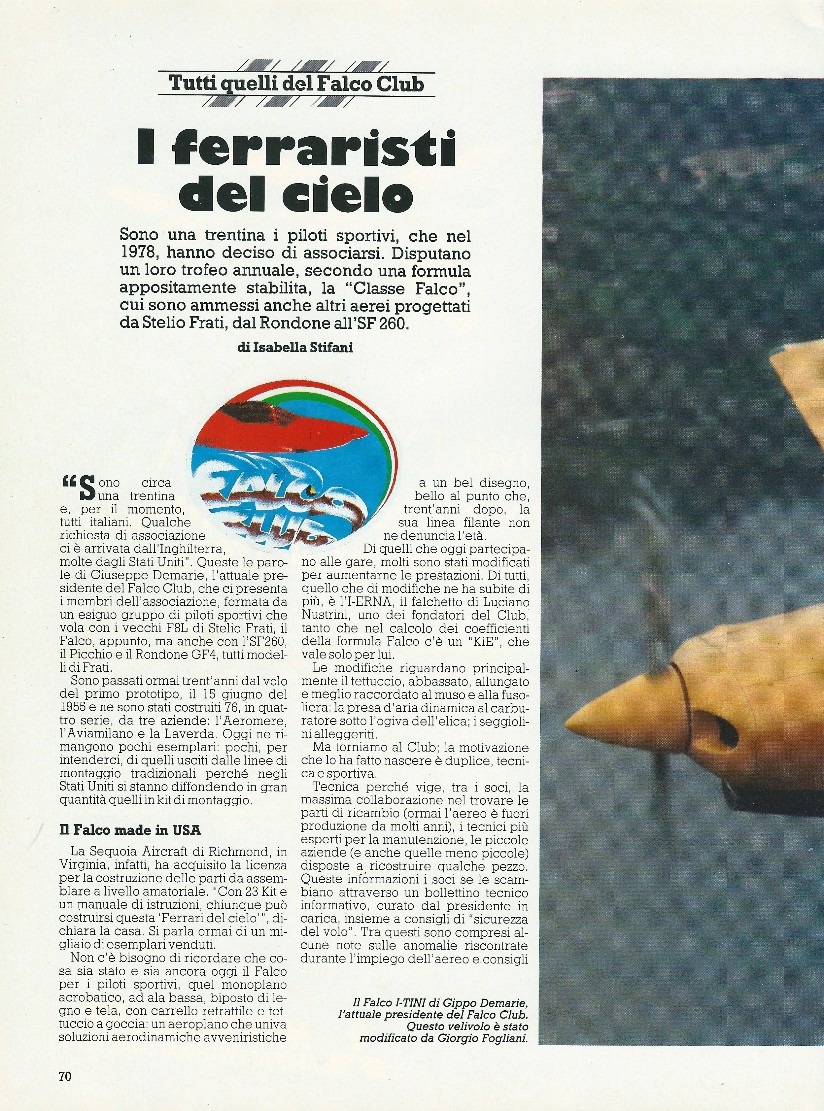
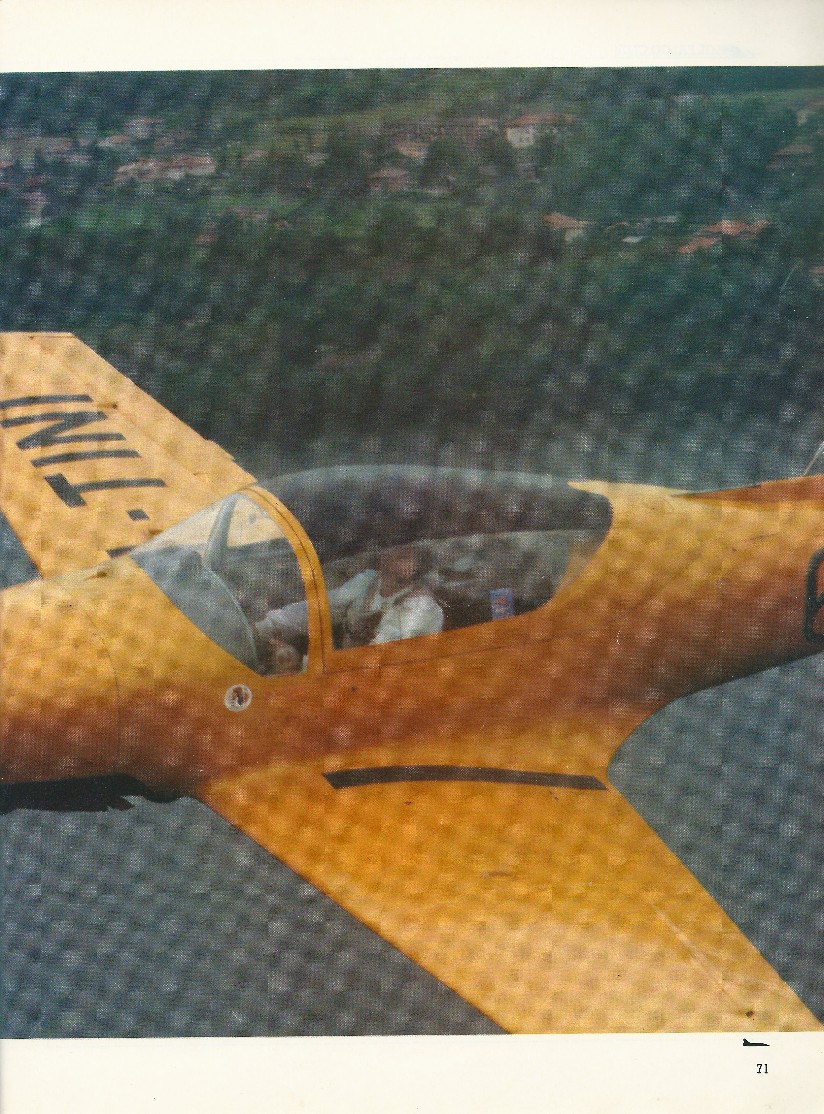
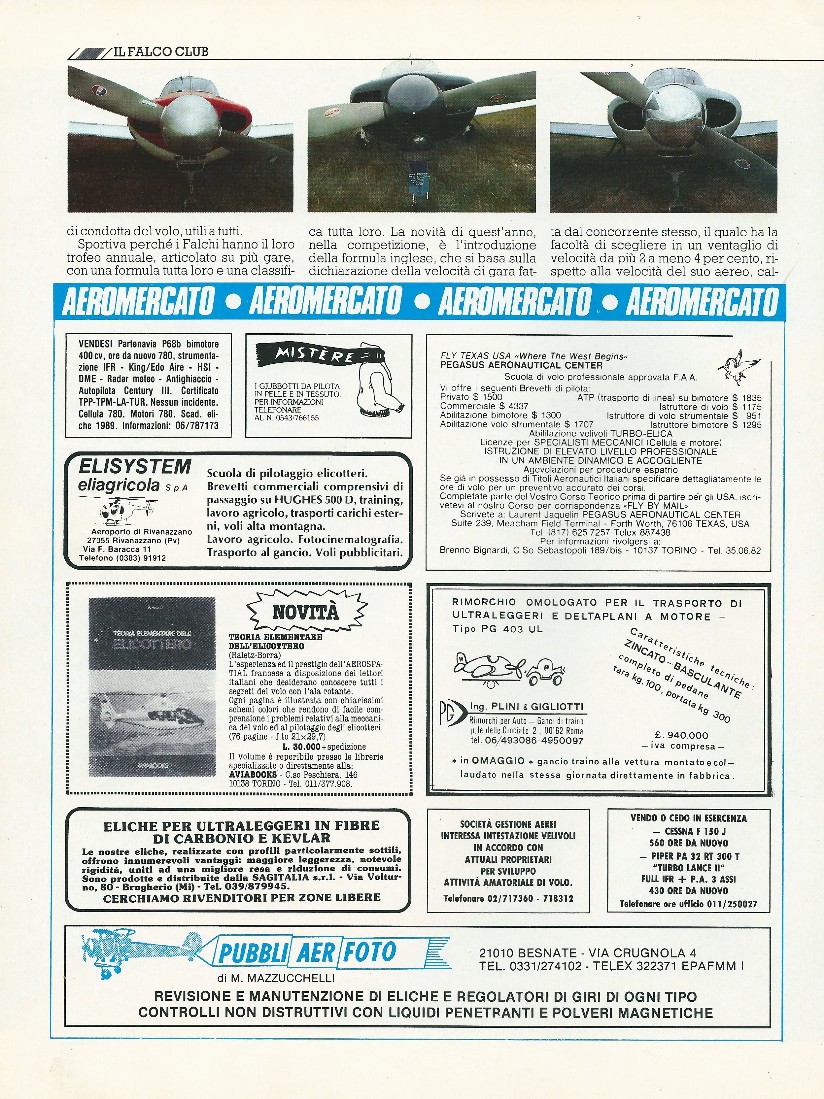
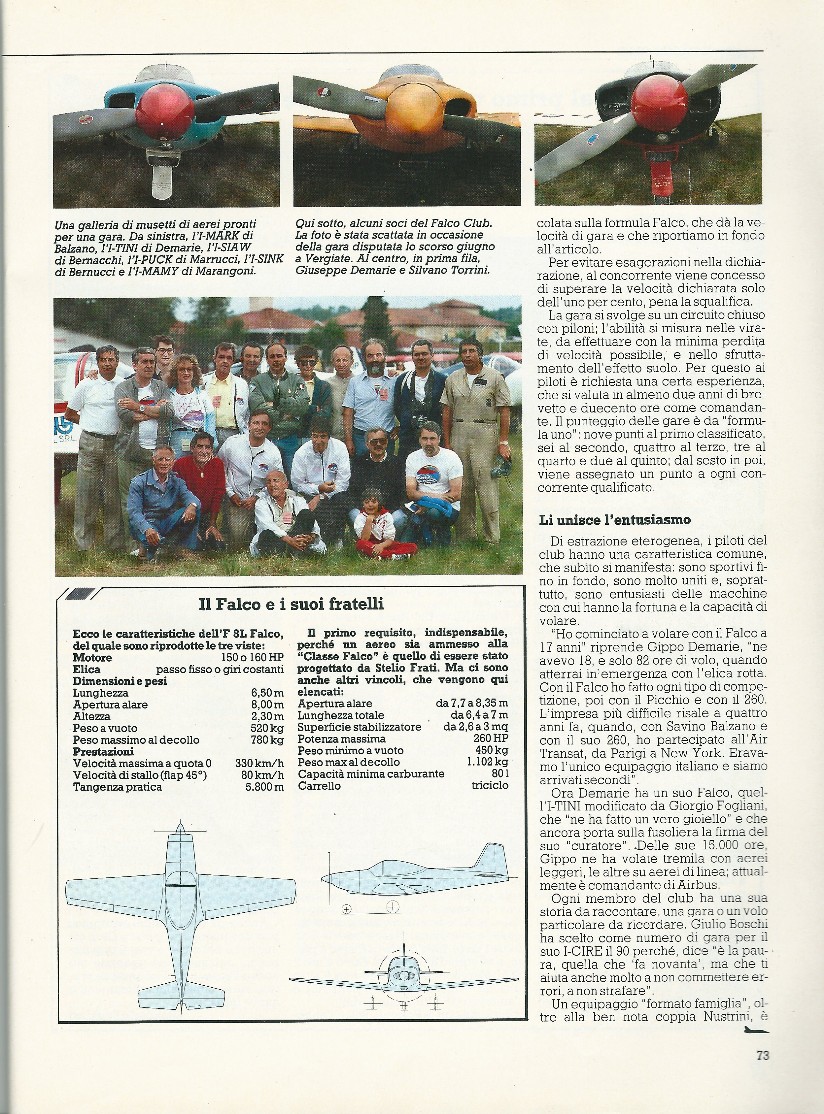
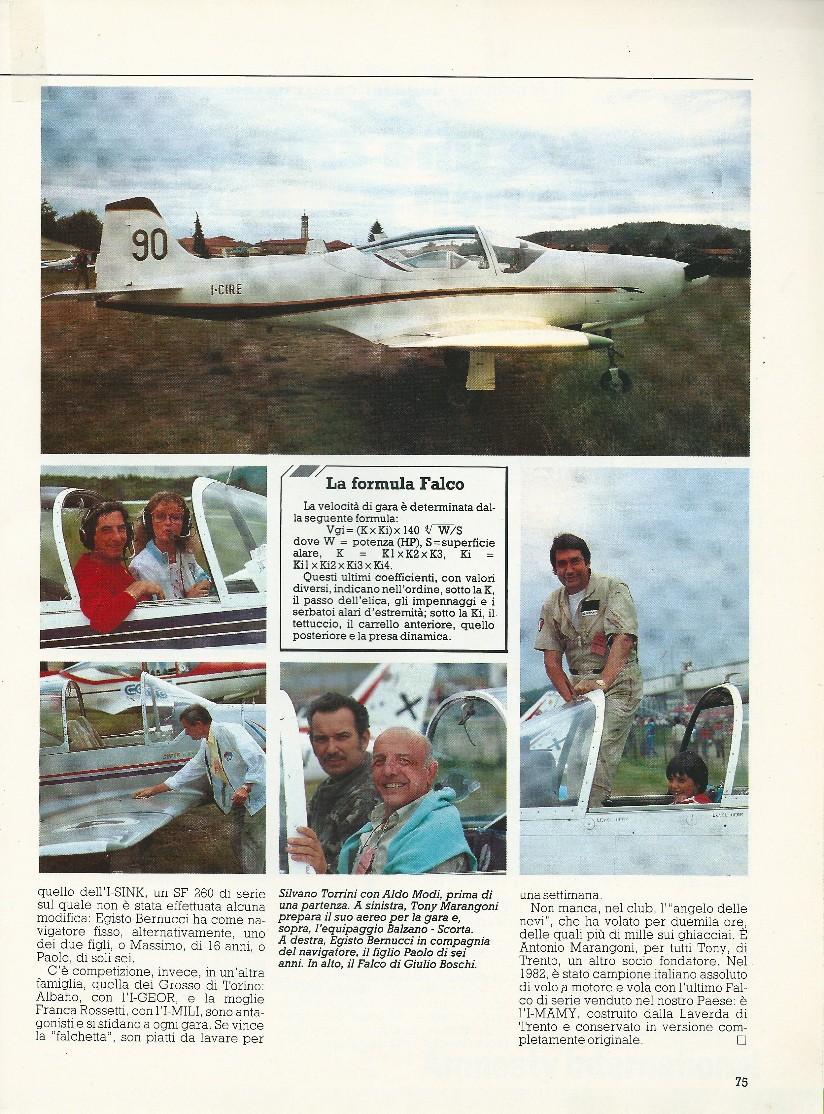
Volare di Luglio, Agosto 1987
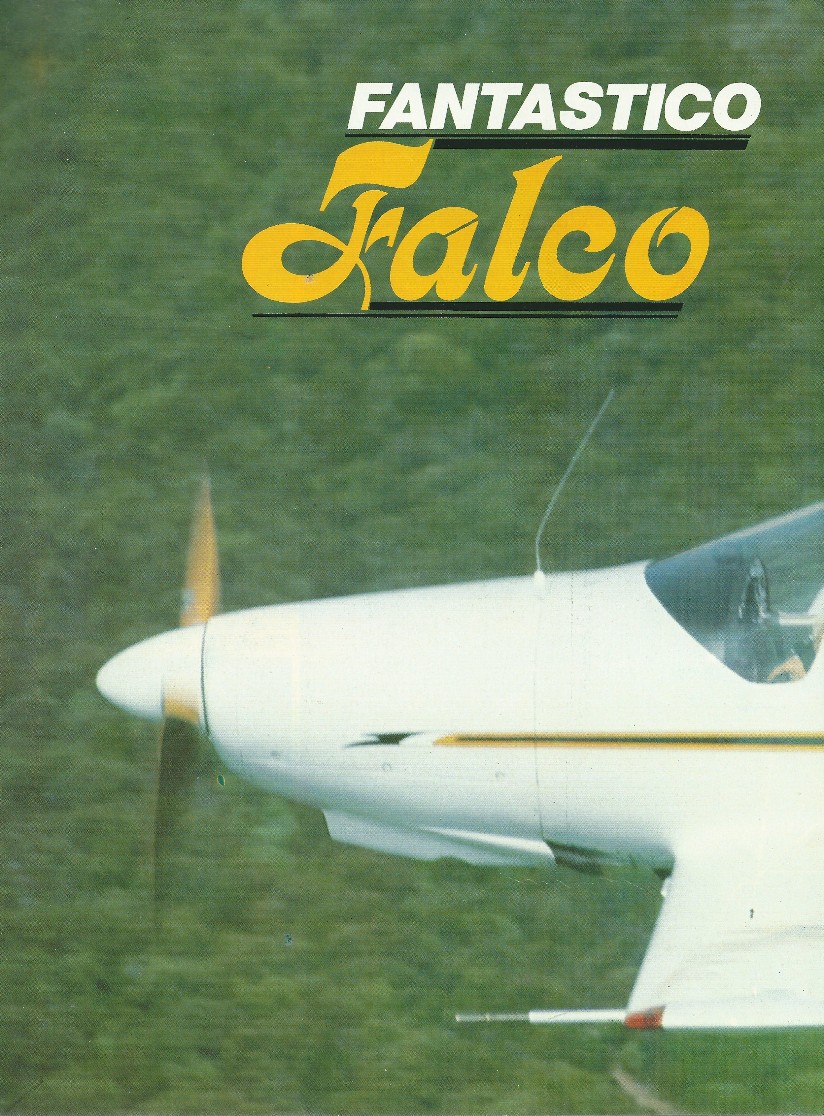
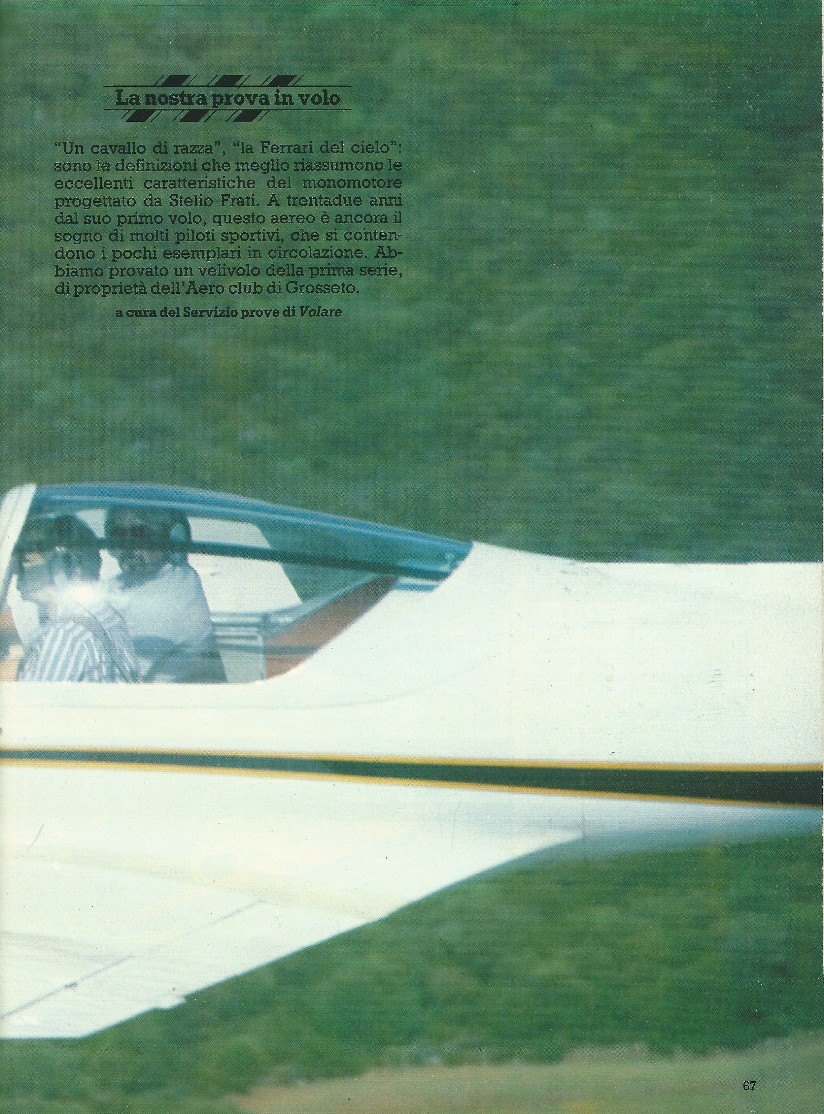
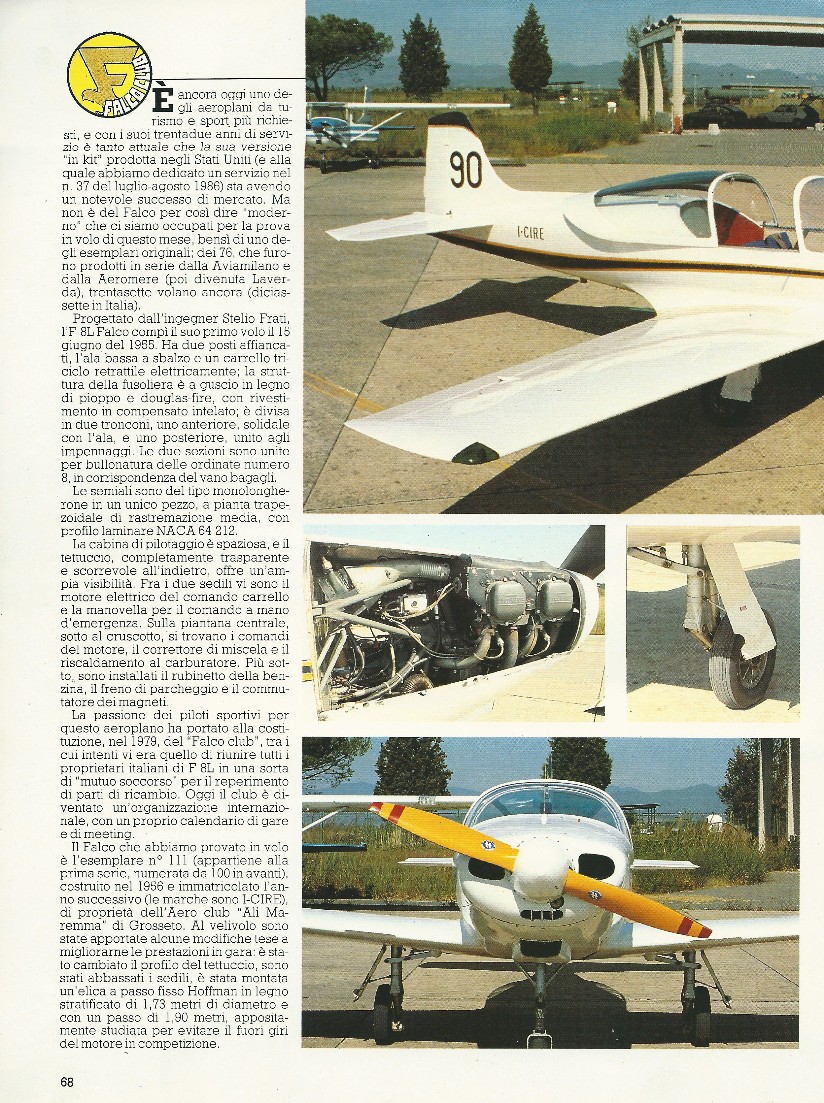
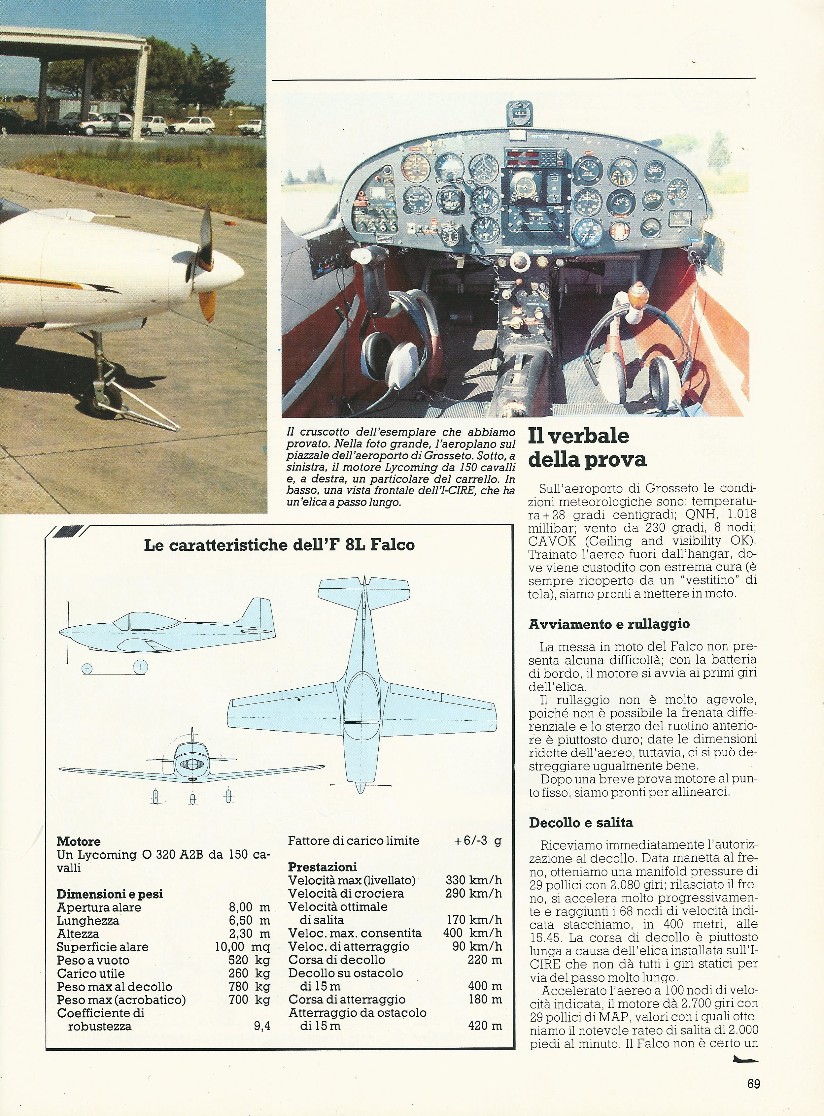
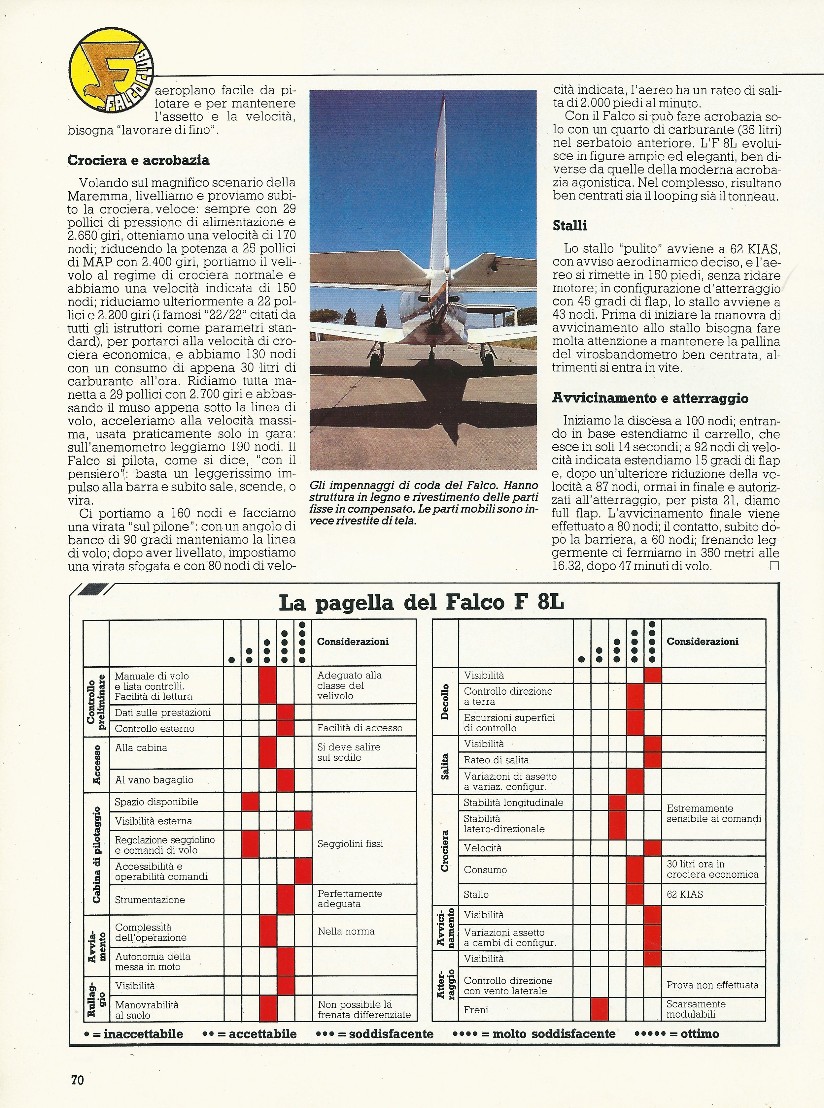
Volare di Maggio 2002
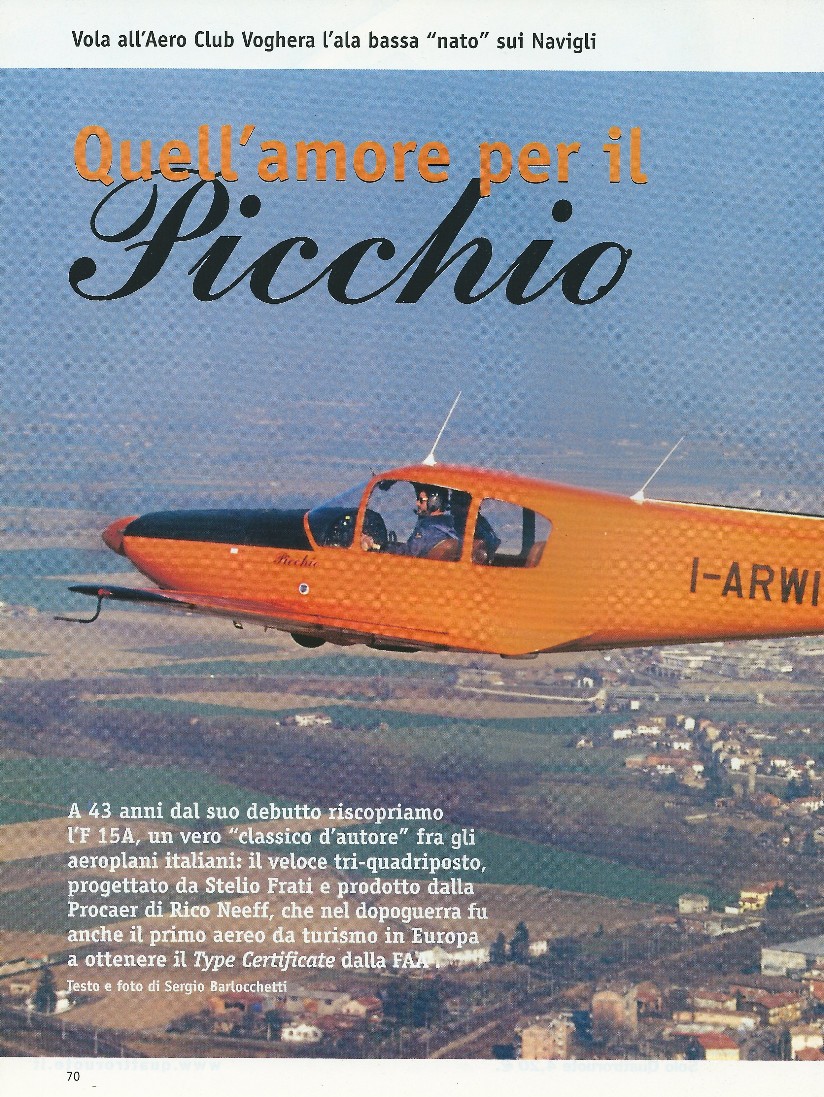
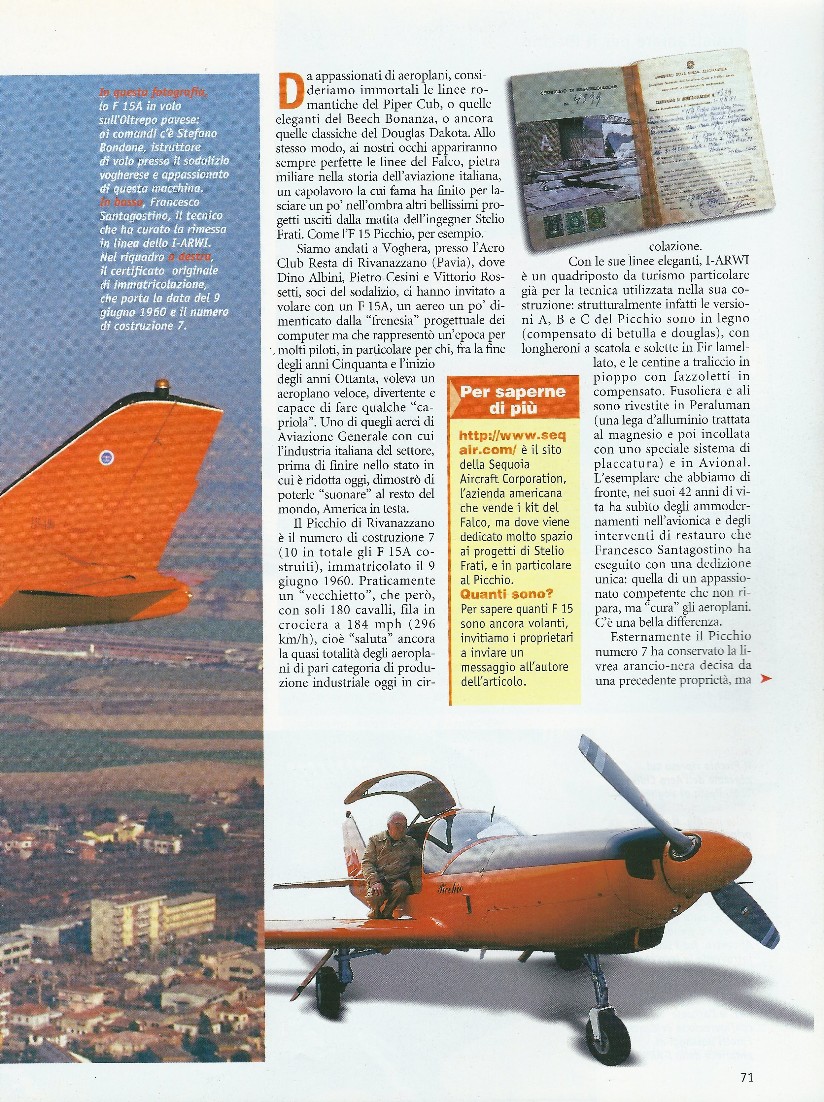
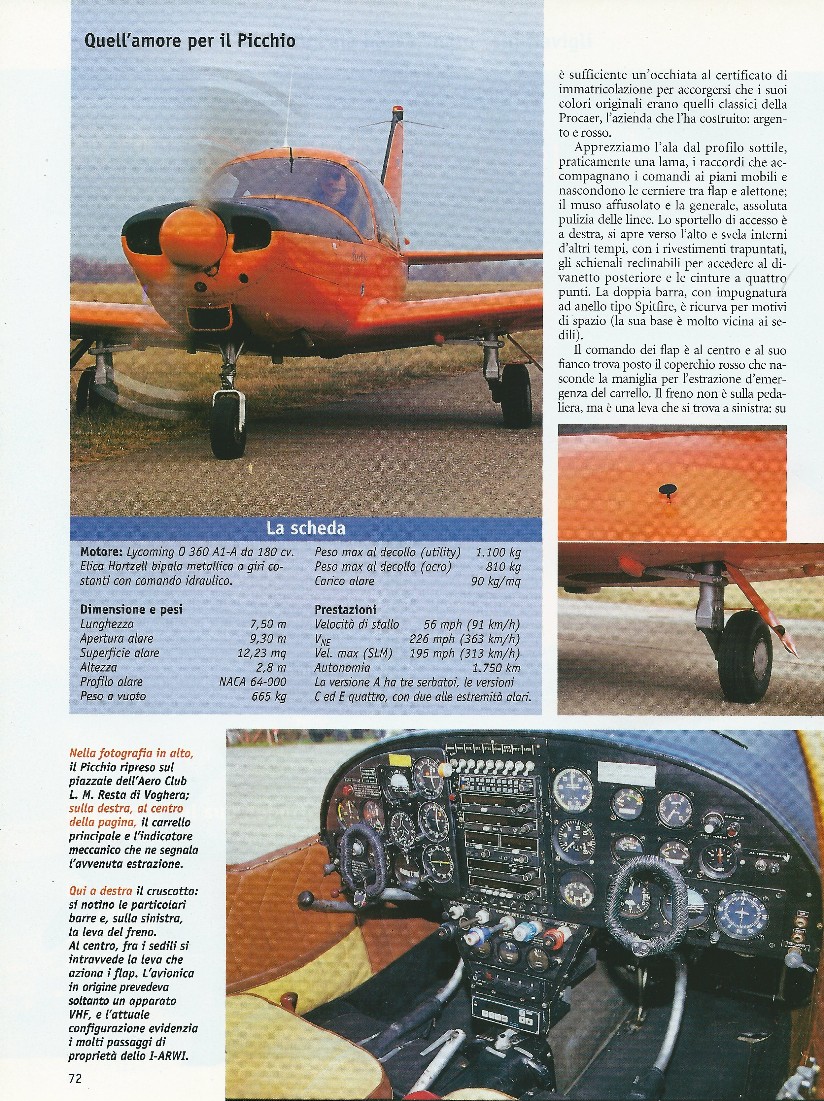
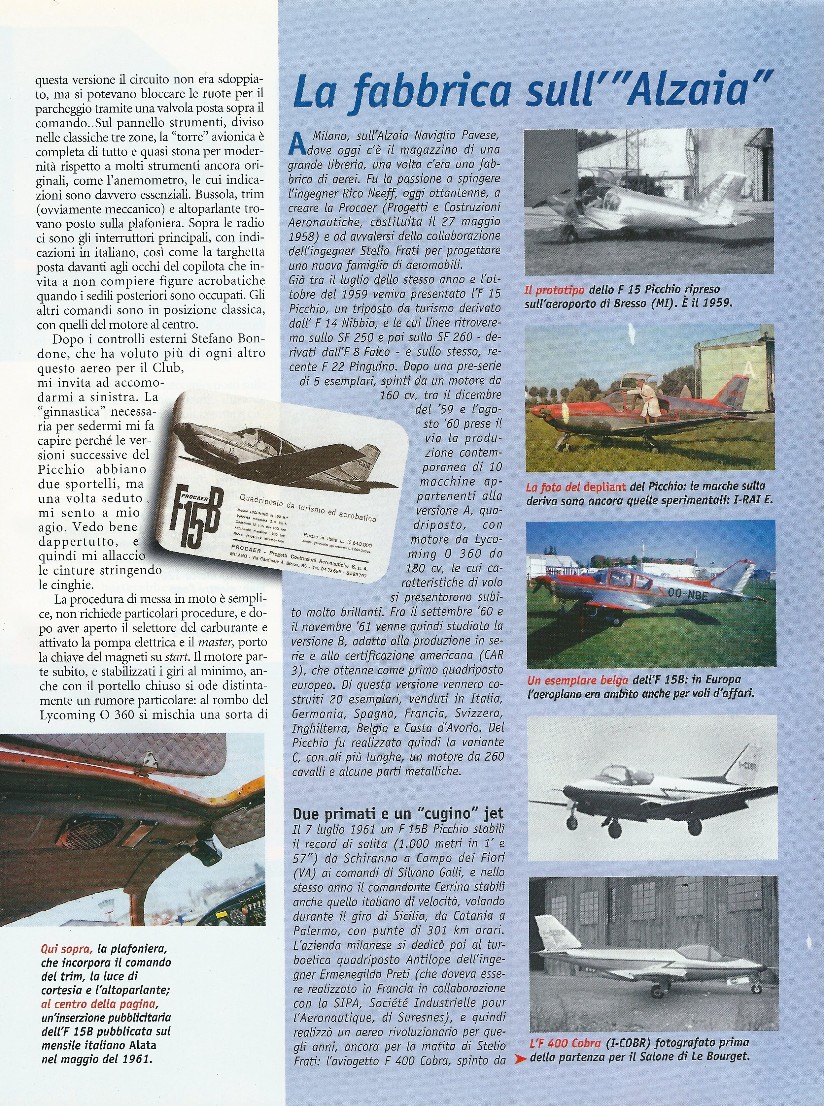
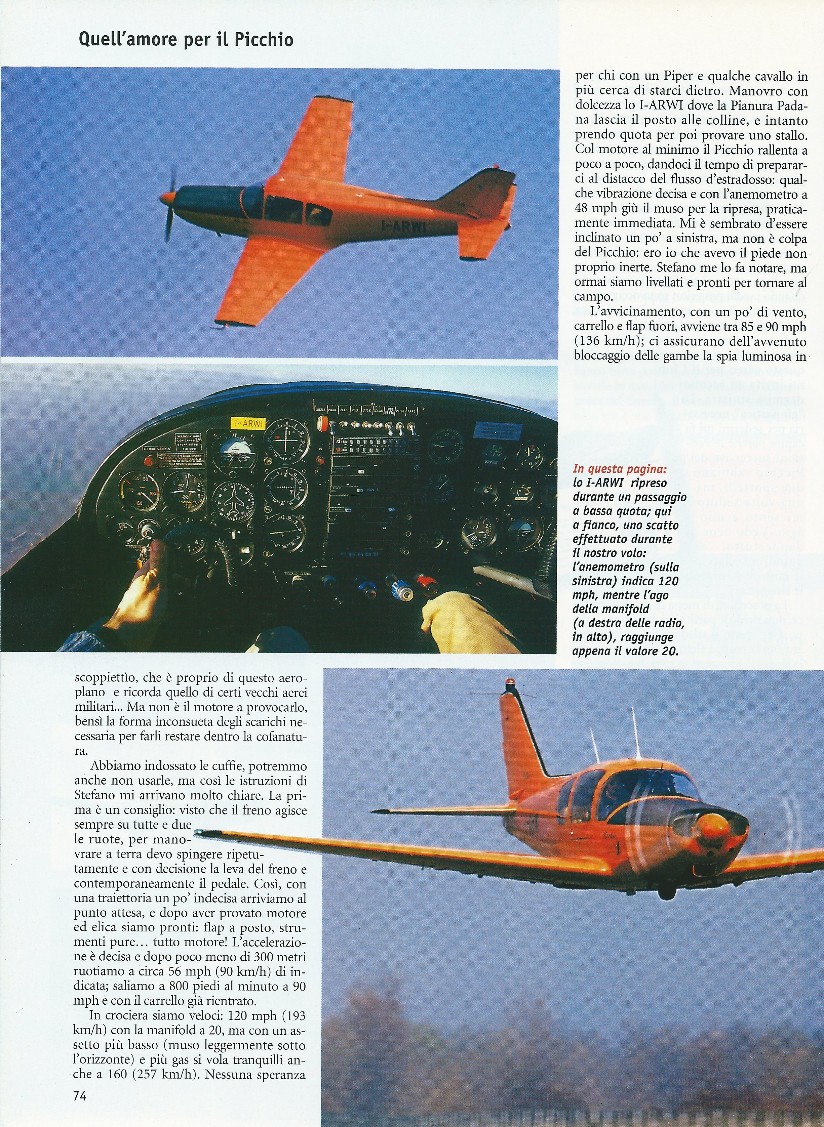

Volare di Luglio 2002
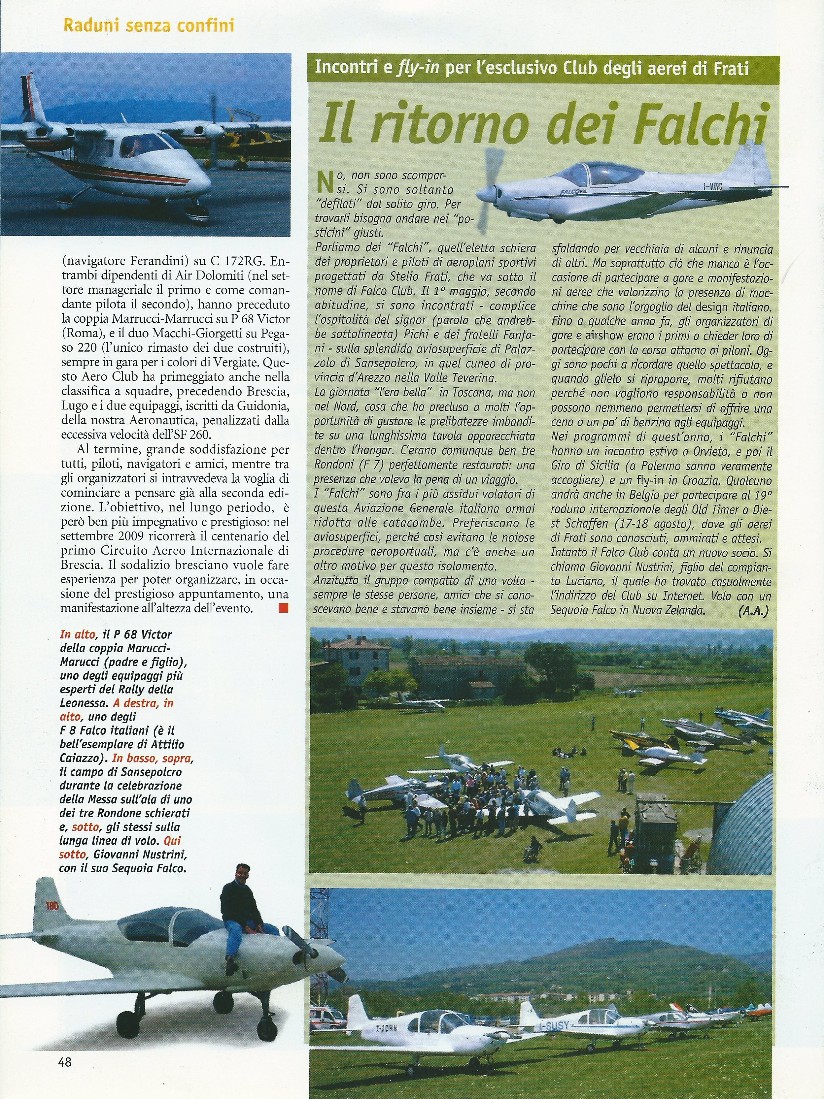
Volare di Ottobre 2002
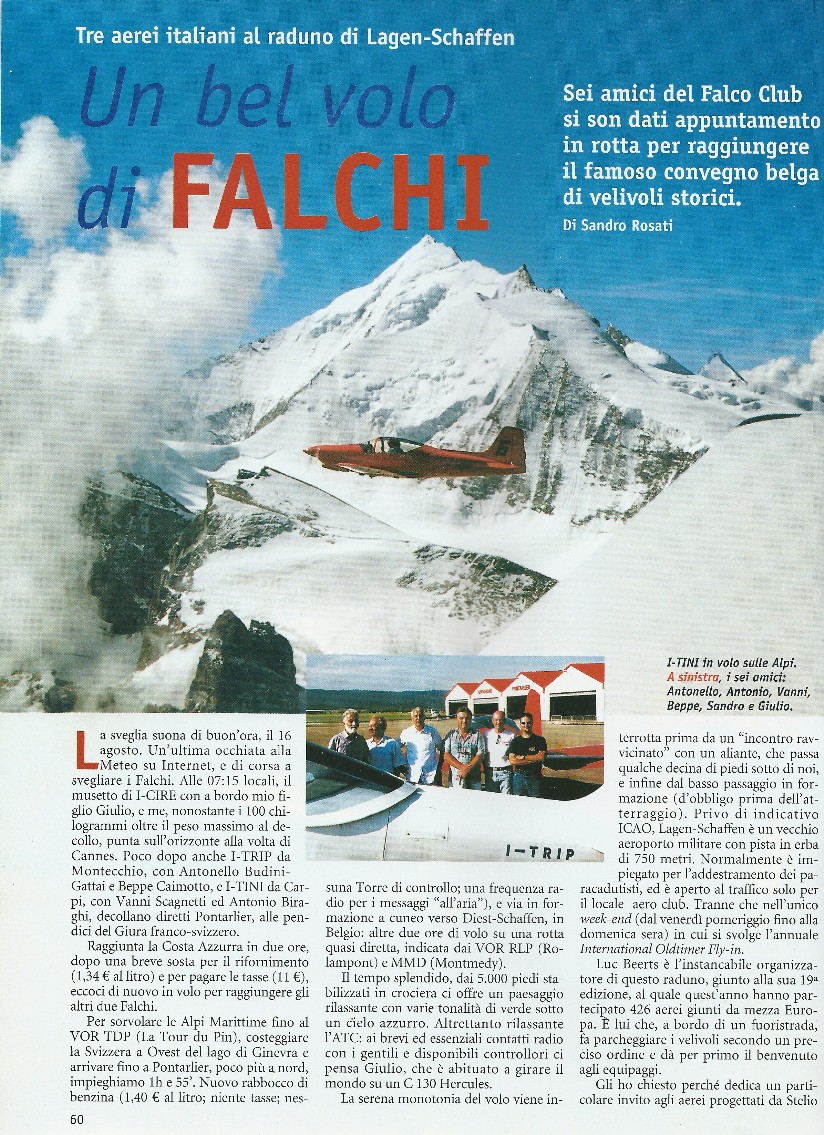
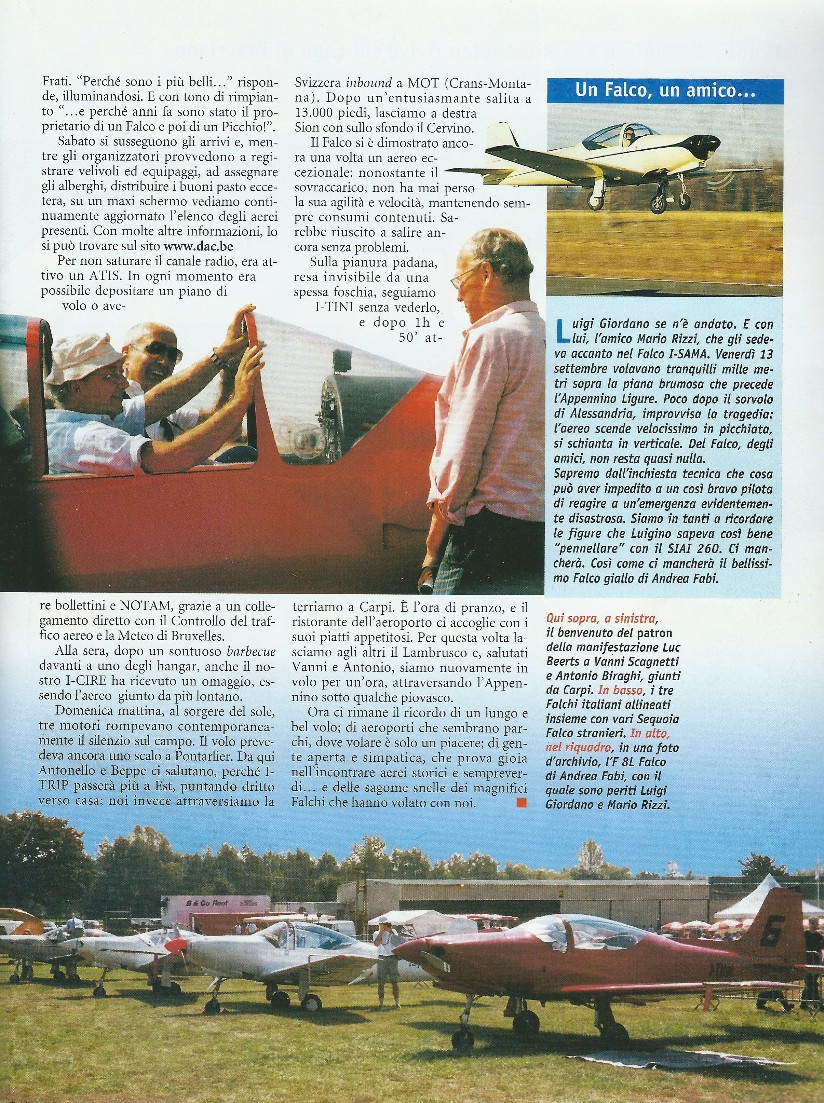
Volare di Ottobre 2005
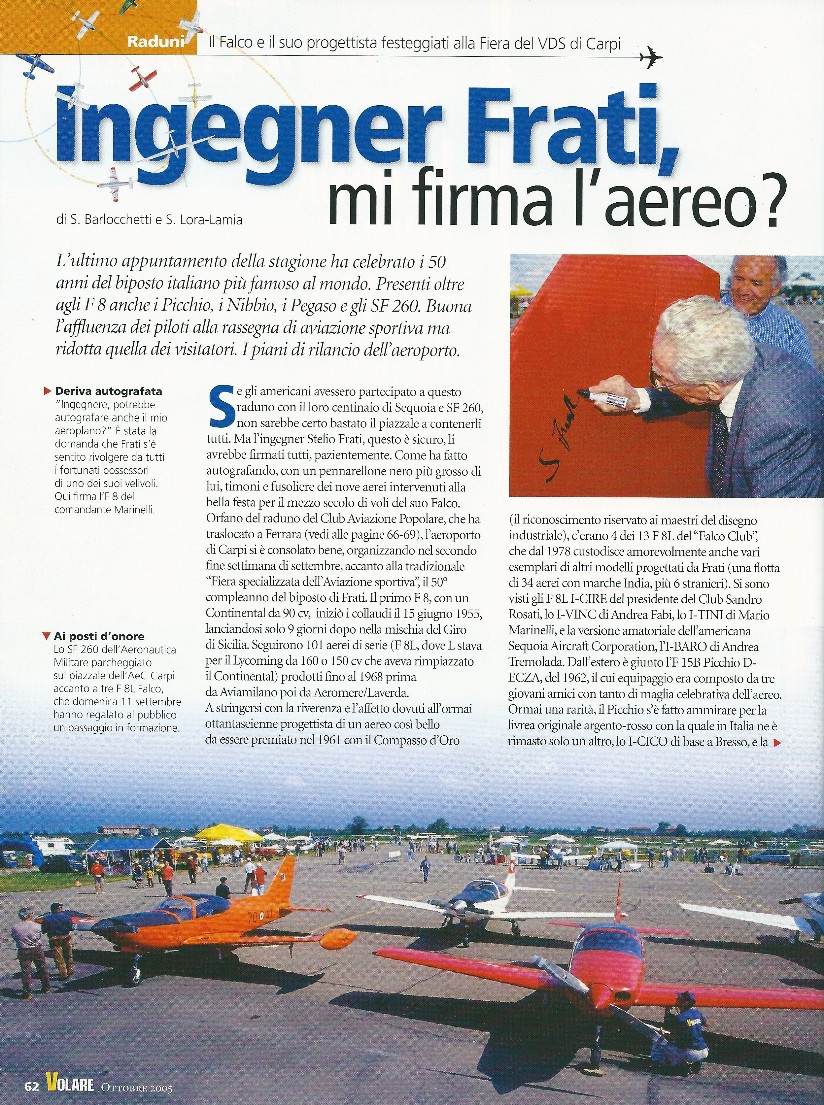
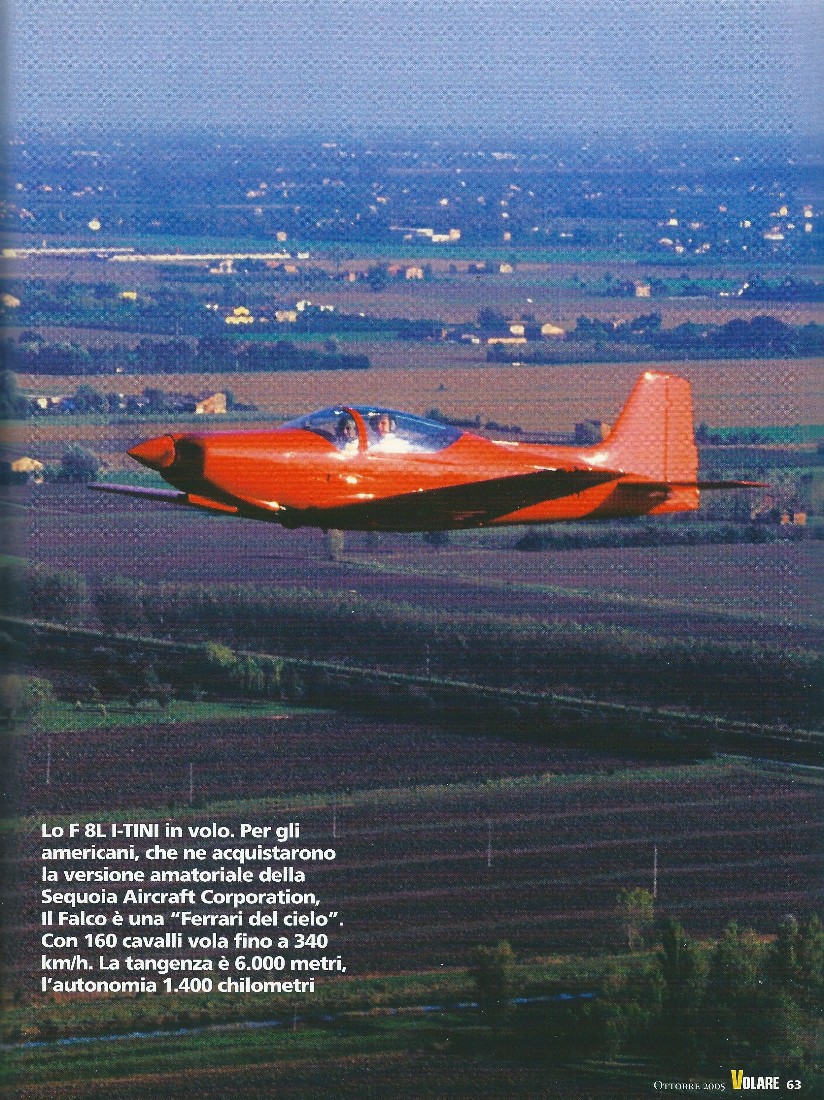
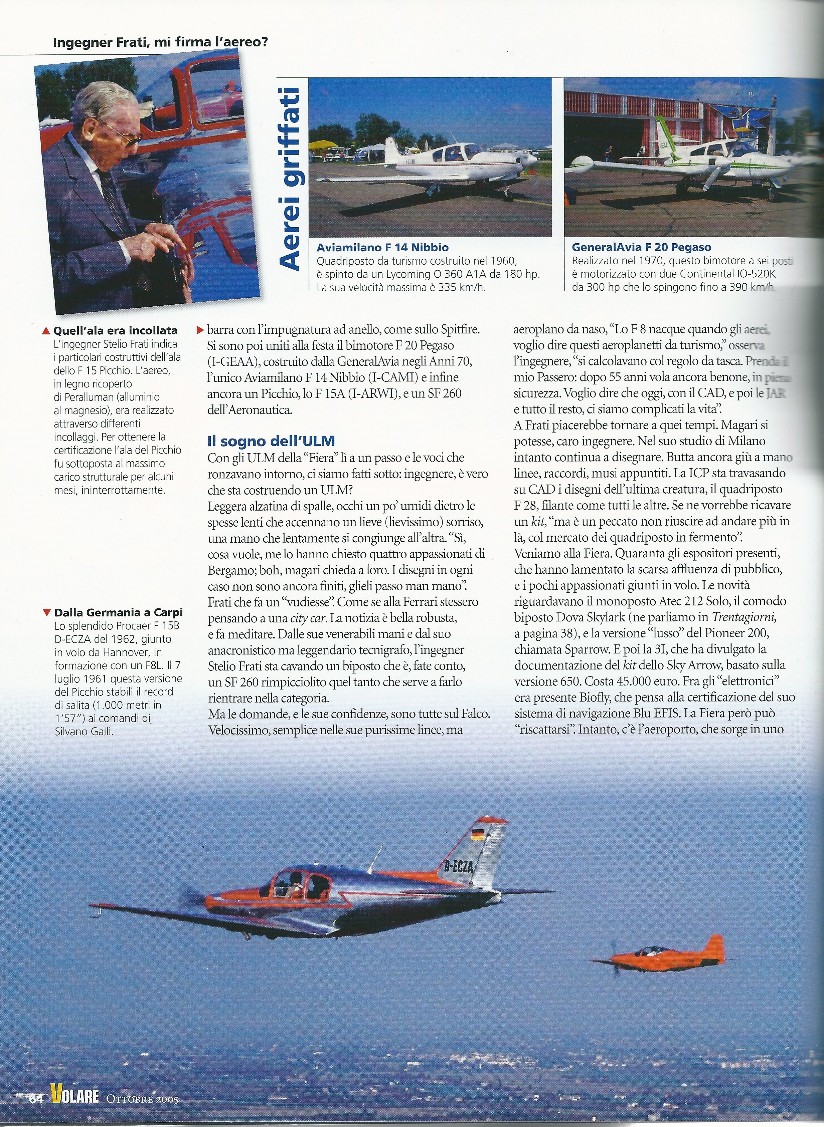
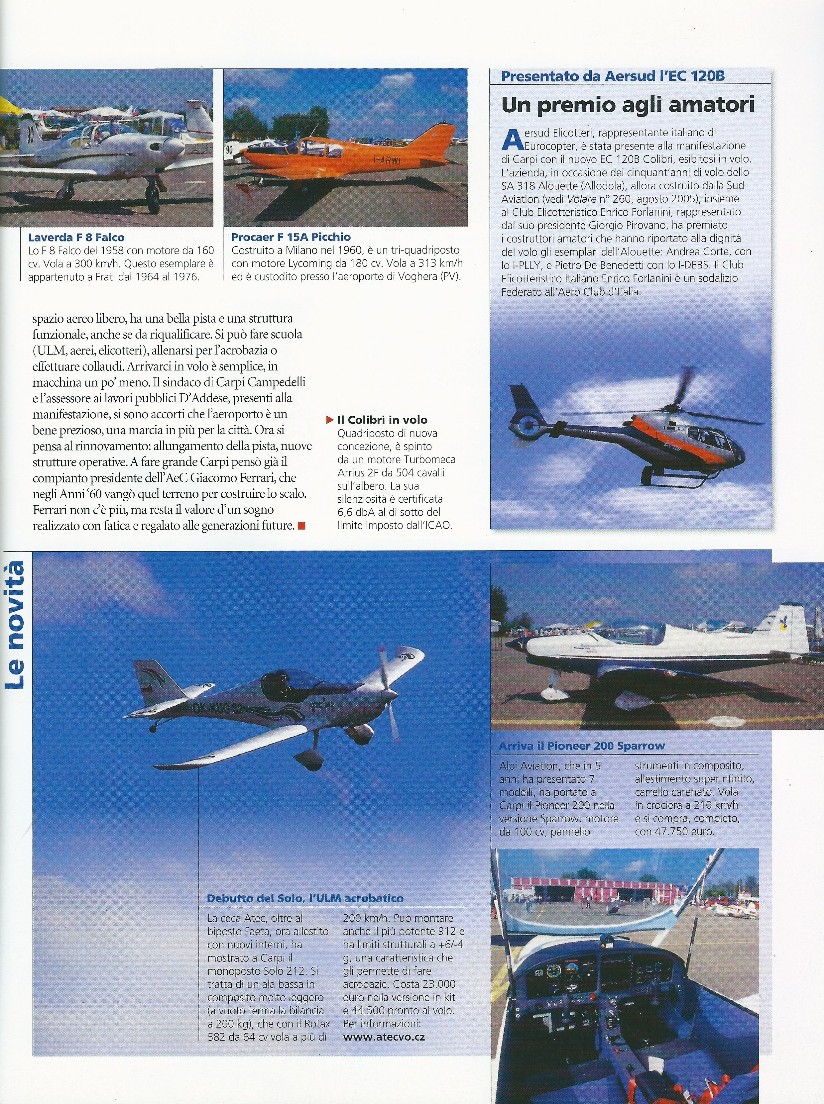
From the day it first flew in 1955, the Falco has been called "the Ferrari of the air".
This Italian design is sleek, strong, agile and fast. There are two seats. Control sticks. A bubble canopy for all-
A superb aerobatic ship, the Falco is a graceful ballerina in the sky. Cuban eights, loops, rolls, snaps and spins are only a flick of the control stick away. The agility is astonishing, and the handling is legendary. The controls are light and precise, and after pulling through a smooth series of rolls and loops, the comparison with jet aircraft becomes inevitable.
The Falco is also strong. Aerobatic certification means the Falco can easily take loads which would break an ordinary airplane. And even for pilots who always keep the wings level, it's nice to have that strength.
The Falco's proven record and engineering puts it in a class by itself. It was designed by Stelio Frati, one of the great aircraft designers of all time. It was certified as a production aircraft. It was built as a production aircraft and has a history of over 40 years of use by pilots in Europe. Now, with many refinements, the Sequoia Falco is a modern, state-
Compared to ordinary aircraft, the Falco is an Arabian stallion among plowhorses. It is a classic, timeless design that has everything you could ask of an aircraft: looks, speed, efficiency, aerobatics, strength, and-
The Falco. A plane for all seasons-
000O000
The following is a translation of one chapter of the book Manche et Manette (Stick and Throttle) by Bernard Chabbert, published by Air Press, 14 Cite de l'Ameublement, 75011 Paris, France and available from them for 120 FF + shipping-
Alfred Scott
........... On the left side of the instrument panel, there is a dial labeled: indicatore di velocita. Airspeed indicator in English.
The figures on the dial go to 400, the marks continue to 450. The units are kilometers per hour. It's not usual, instruments reading that high. There's also a red line painted on the glass, at 383 kph, and a placard on the instrument confirming that this is the Vne. Speeds like that apply to 700 hp twins, you say.
"Ma no, str..zo! This is an Italian airplane, idiot, and Italian machines are made to go fast, capito?" Moreover, this Italian machine is the golden standard of pure performance and elegance in a sporting design. Anglo-
Go ahead, tip your hat: Stelio Frati is passing. If you want to place him in the ranks of contemporary Italian engineer-
If you are a violinist, you've dreamed of playing a Stradivarius one day, just as pianists dream about the Steinway, vast as an aircraft carrier, on which Bernstein interpreted the Rhapsody in Blue. If you're an aviator-
In the Seventies, you could have bought an old Falco for 50,000 French francs [$10,000]. Then, we found it tiny, tight, noisy-
In the Seventies, I flew a Falco based on a superb airfield in a valley near the Alps. At that time, the instructors of the club considered that it wasn't enough to be capable and to want to fly it, but also worthy to climb the steps of a temple reserved for the initiated.
The expression, "casting pearls before swine" takes on its full meaning when one speaks of flying a Falco. It's not very difficult, no, rather it is subtle, nuanced. It's better, then, to keep such an airplane for true lovers of flying-
In the nose, there's 160 hp. For such a small airplane, it's a lot. When you see how Frati cowled the engine, you'll want to burn all the other airplanes on the ramp. It's awful to see that they still build flying machines with noses like cauliflowers when the machinery of the Falco is housed in such a refined profile. The best of it is that the cowling is no harder to open than any other, and it cools as well as any normal airplane.
The Falco is wood, all wood. But it could have been made of ivory, the surface is so smooth. You're wide-
The front, with the engine-
That's followed by the biggest chunk of the airplane, the center section with the wing and cockpit, constructed like a boat hull, and of a quality that has nothing to do with ordinary cabinet work-
And to finish, there is the rear fuselage, a spindle of great purity that ends in triple petals made by tail surfaces of the same construction.
The Falco is very precisely made by the most expensive-
Va bene: It's a Falco, yes, but it's also an airplane. On the right, the instructor has carefully explained how everything should be. You check the parking brake before firing up, and that's the first surprise. Frati is without doubt a great airplane designer, but he has never noticed how a man is designed, physically and psychologically. The Falco braking system proves it.
On the left, under the instrument panel, there is a big horizontal handle. Normally, a handle is pushed, or it's pulled. Not this one. To make it work, you must put two fingers on it and push it downward very hard. This puts both main gear brakes on at the same time. There is no differential, left-
Now to set the parking brake. Pump this handle down a couple of times, and then pull on a knob placed above the lever that resembles the piston of an enema pump like the one the set designer of the Comedie Francaise still has, for Le Malade Imaginaire. Strangely, the piston stays pulled out. It must work. Especially since the instructor seems happy.
You look for the primer. No pump. It's like a car. So you shout, "Clear," turn the key to both magnetos, give the throttle a couple of pumps to squirt fuel into the cylinders, and hit the starter button. Brammmm. It's started. The noise is intense but agreeable. Nothing like the clattering and bangings of modern airplanes made of thin aluminum sheet. It's smooth, powerful, flat. If you wear a headset, it's even bearable.
Let's go. First the parking brake. Push in on the enema pump piston, jiggle the handle under the panel a couple of times to make sure, and the airplane's rolling. Brake test: push down on the lever, and the airplane vaguely pretends to slow down a little. Got it-
For my part, I prefer airplanes that fly well and have a hard ride on the ground to those that ride like Cadillacs and fly like paving stones. Oh, yes, those exist. But let's stop psychoanalyzing the Falco on the ground and get it into the air.
End of the runway. Checklist. Try the controls. You wiggle the stick, and find it hard to believe that there are surfaces at the end of the linkage, it's so light. You need to look at the wings and the tail feathers to be reassured. Yes, they're out there, and they move. Immediately, anxiety-
The visibility is phenomenal. You have a superb view of the runway, ahead and to the sides, and you advance the throttle deliberately, without braking. The airplane starts instantly in the dull fracas of the engine, accelerating like a Group B Lancia rally car, straight ahead like a jet. By the time the throttle is full on, you're already at 100 kph! You're a little stupefied, you let a second pass and force yourself not to pull back, not even press the stick aft, to take off. Think, "I'll take off," the thought runs along your arm to two fingers delicately poised on the grip, and the Falco flies away, straight as a string. Bring the wheels up, hit the switch, and the cockpit erupts with the sound of a palace coup-
You climb, you think about things like "right turn, 45 degrees bank angle," and the Falco swings right at 45 degrees. Or "level off," and zip, you're there. It doesn't obey you, it's an extension of the pilot. And it never goes farther than you ask it.
With behavior like this, right away you find yourself exploring the airplane in a peaceful corner of the sky. 30 degree turns? Ridiculous. Uninteresting. 45 degrees? Easy. The ball stays glued in the center of its tube the whole time. A 90 degree bank? Let's go. Index finger presses the stick perpendicular to the horizon, and your buns are welded to the seat. Tighter? A millimeter more aft stick, a little more g, another millimeter, you feel your cheeks start to sag, another millimeter, your elbows are heavy. Okay, boom, you reverse in the other direction! And in two seconds, as though on rails, the Falco finds itself in the same turn, but in the opposite direction. It's bewilderingly easy. It's the simplest flying, the purest that one can imagine. This airplane with the reputation of being touchy is, in fact, unbelievably docile. Yes, it is hypersensitive, but not hysterical. It obeys. It's faithful. It only does what you ask of it. And it does it instantly. An Alphajet is like a Renault R5 alongside this.
Never has an airplane so well deserved the nickname "little fighter." So, let's fight. We're in level flight, at 270/280 kph (cruising at 24 inches and 2,450 rpm; the performance of a good commercial airplane with twice the power). A little back pressure, hold it. Some g force, the nose climbs, climbs in the pure, clear skies above the edges of the Alps. Very softly, I roll to the right, the wing descends, and we make a beautiful chandelle.
Let's do that again. The right wing lowers until it points at the greenery far below, and the sun bursts into the cockpit, warming the face and hands. Turn slowly, and the nose tips down, very softly. I don't touch the engine, still at cruise power, and we drop into a slight dive-
The instructor stops my hand. "No. Leave the nose down. Let it go."
"How far shall I go?" I ask.
"Vne."
All the way to the redline, then. It accelerates continuously, peacefully, a little frightening.
Three hundred and fifty kilometers. I've never gone so fast in a little single engine airplane in a shallow dive. It's not all that fast, in absolute terms, but in flying, everthing's relative.
Toward 360, I bring the nose up, very, very gently. Despite my care, I feel the airframe load up, as in a real fighter. The cowl comes back to the horizon, the airframe whistles a little. It keeps 360 kph without effort, flowing through the air with grace, like a salmon. Most other airplanes jostle the atmosphere to force a path through it, using a lot of power and energy. I mumble a few comments, and the instructor laughs.
"You should know Frati's test pilot pushed the Falco up to 600 kph!"
Evidently, I'd forgotten. [So has Frati. Don't believe this.]
It took a good two minutes for the speed to fall to 290, where it stayed with cruise settings. Consumption is then around 30 liters [7.9 gallons] per hour. It's sublime. The design of this airplane dates to 1955, and not only is it an exceptional beauty, but also its performance beats everything made since, even by Frati!
But there you are. Since then, engineers have emphasized making airplanes easier to fly, safer at low speeds, harder to stall, harder to spin inadvertently-
I slowly pulled the power off completely, not letting the Falco lose altitude. And I went at least fifteen kilometers to get down to 130 kph. I squirmed in my seat. With these tiny wings, thin as knife blades, it's going to stall sharply. Be alert. I started to drop the flaps and the gear, but the instructor stopped me.
"No, leave it clean. It's sportier."
That's what worried me.
3,000 feet. The engine murmurs, I hold the nose high, on a slope of at least 20 degrees, and I wait for the aerodynamic cataclysm. The ball is centered. The speed falls. 105 kph. Nothing. Then suddenly there's the impression of being machine-
So I'll play a nut case. I haul it back brusquely, the nose climbs, and bam, the Falco's gone, the left wing moves down, my right foot does, too, in the next half-
There's nothing left to do but land this Milanese jewel. Directly above the field, downwind, power back, I let the speed fall to 170 kph, put the gear down and in the process set 20 degrees of flap and 20 inches of manifold pressure. Level flight. The airspeed needle is exactly on 160. I verify that the wheels are out by looking at each wing-
160 kph is a little faster in the pattern than most light airplanes. Let's slow down, toward 130 for the stall speed of 100, just as the book says. 13 inches. Full flaps. Prop full fine pitch. 145 kph. A touch of power to lock that in. And with a finger, the last turn.
It's a dream, this airplane. A prosthesis for flying. You don't have to know how to fly. It's enough to look where you want to go, and it goes there.
Lined up on the runway, I leave the trickle of power that seems necessary. We slide down rails. Little gusts don't even have time to tip the airplane; I kill them instantly with tiny pressures. We pass the threshold at two meters. Round out, stick back a finger's width, and I gently remove the last trace of power.
The nose rises a little, the airframe whispers, it... thump. The wheels touch. Life is gone instantly. The nosewheel descends. Touches. Nothing left but to brake.
Ah, that's right. The brakes. Okay, don't brake. It doesn't matter, it's a long runway. The instructor speaks.
"Hell of an airplane, no?"
I've heard all kinds of things about the Falco. And I continue to hear all sorts of stories, of the "this airplane is a booby trap" variety.
So much the better. Let's hope that lots of people keep repeating it, that it's very, very difficult to fly. Very, very vicious. Let's not hold back anything. That way, there'll be room for the others, those who know-
In any case
000O000